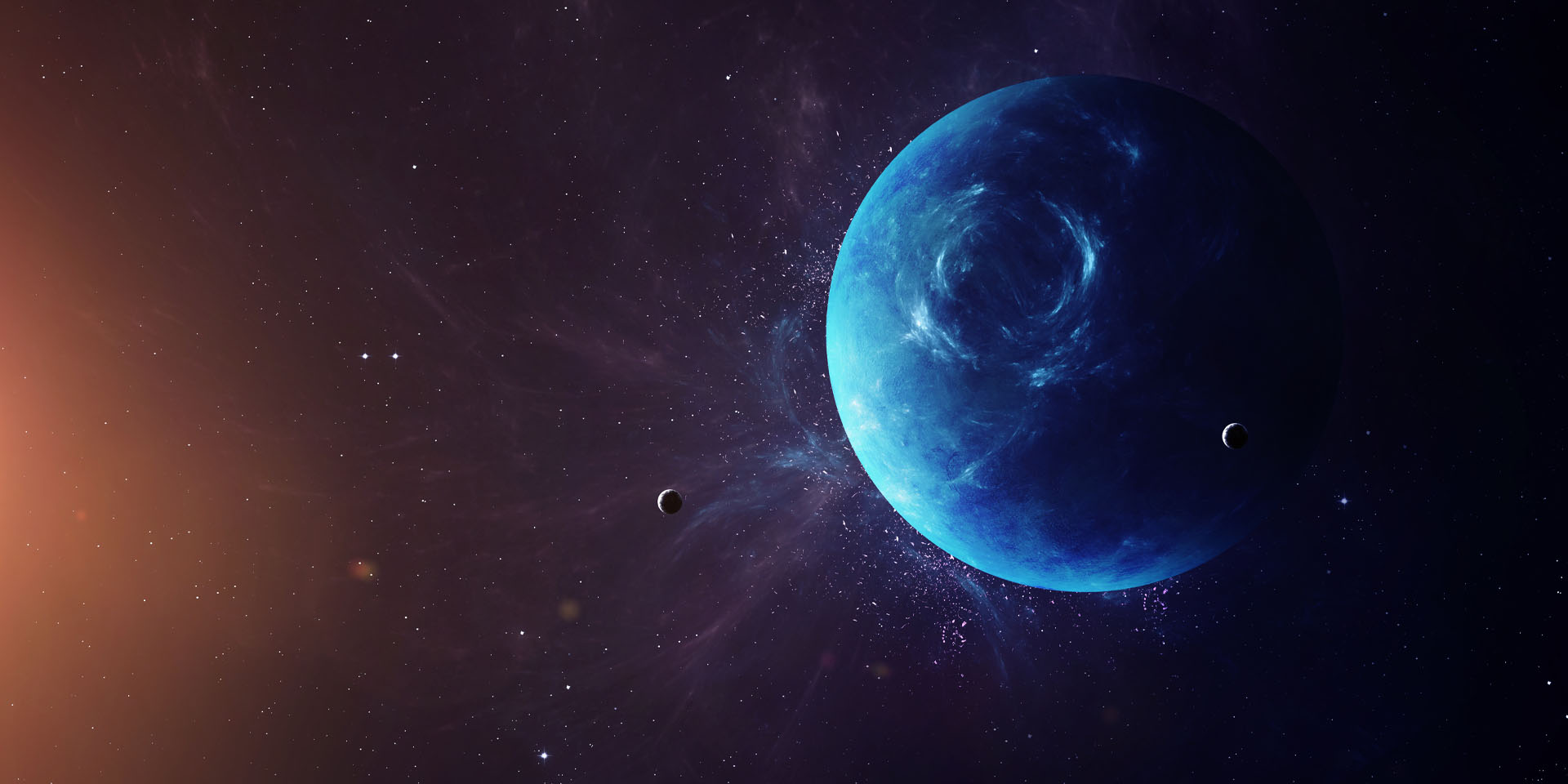
SUB.J | Neptune

It’s little wonder that Neptune is another dark, cold ice giant. Last of the known planets, Neptune is so far away that it takes nearly 165 Earth years to make a single orbit of the sun (and yes, that’s the longest year in the solar system). It takes sunlight almost four hours and forty minutes to reach Neptune, and a day there lasts about 16 hours.
Similar to Uranus, the blue coloration of Neptune is due in part to its atmospheric methane, which absorbs red light. Unlike Uranus, Neptune is a deeper blue, so there must be some other atmospheric component that Uranus doesn’t have. Due to its blue coloration, Neptune was named after the Roman god of the sea.
It’s lonely out here, but even Neptune has children in the form of its fourteen known moons, Triton being the largest of them. Triton was discovered just a few weeks after the discovery of Neptune itself.
Neptune’s moon Triton is special in its own right, because it’s the only large moon in the solar system that circles its planet in a direction opposite to the planet’s rotation (a retrograde orbit), which suggests that it may once have been an independent object that Neptune captured. Triton is extremely cold, with surface temperatures around minus 391 degrees Fahrenheit (minus 235 degrees Celsius). And yet, despite this deep freeze at Triton, on its 1989 flight, Voyager 2 recorded geysers erupting nitrogen gas and dark dust particles straight up, almost five miles into space. Triton’s thin atmosphere, also discovered by Voyager, has been detected from Earth several times since, and is growing warmer, but scientists do not yet know why.
Scientists believe that eventually, Triton will break up and become part of Neptune’s ring system. Yes, like Jupiter, Saturn, and Uranus, Neptune has rings. Neptune’s five rings are made up of small rocks and dust, and are rather thin and faint.
Like the other gas giants, Neptune is a ball of gas and ice, without a solid surface layer. Instead, it has a slushy ocean of water and ammonia. If you could stand on the surface, though, you might notice that the gravity on Neptune is only 17% stronger than on Earth. How does that work? Neptune has 17 times the mass of Earth, but is also 4 times larger. The result is that the greater mass is spread out over a larger area, so the gravity ends up being almost identical.
Neptune has the strongest winds in the solar system – even stronger than the famous winds of Jupiter. Imagine a storm with winds that go up to 1500 miles per hour. In comparison, U.S. daily wind speeds are usually between 6 and 12 miles per hour, and the highest recorded wind speed on Earth was 231 miles per hour. Neptune has a storm similar to the Great Red Spot on Jupiter. It is commonly known as the Great Dark Spot and is roughly the size of Earth. Just south of the Great Dark Spot is a bright area that Voyager scientists have nicknamed “Scooter,” and south of that is the Dark Spot 2.
Though Neptune has the coldest average temperatures of all the planets in the solar system, (ranging from about -328 °F to -360 °F) its core reaches temperatures of up to 12632 °F, which is hotter than the surface of the Sun!
But how does a planet with surface temperatures as cold as Neptune’s generate such incredibly strong winds? Wind on Earth is a result of some air being warmer than the rest, lowering the pressure and causing the air to move. On Neptune, the super cold temperatures and flowing gases might reduce friction enough for winds to form.
Neptune wasn’t seen by ancient civilizations, or even discovered through a telescope (Galileo did see it, but since he thought it was a star, he doesn’t get credit for the discovery). Neptune was discovered by using mathematics. After the discovery of Uranus in 1781, astronomers noticed that the planet was being pulled slightly out of its expected orbit. Astronomers in both England and France used mathematics to predict that the gravity from another planet beyond Uranus must be affecting the orbit of Uranus. They figured out not only where the planet was, but also how much mass it had. In 1846, Johann Gottfried Galle decided to search for the predicted planet and observed Neptune for the first time.
We’ve travelled billions upon billions of kilometres through our massive local neighbourhood, but in the next lesson, we’re leaving the suburbs and heading out…beyond.
Curriculum Reference Links
- Earth and Space / Building Blocks/ 1: Students should be able to describe the relationships between various celestial objects including moons, asteroids, comets, planets, stars, solar systems, galaxies and space.
- Earth and Space / Building Blocks/ 3: Students should be able to interpret data to compare the Earth with other planets and moons in the solar system, with respect to properties including mass, gravity, size, and composition.




